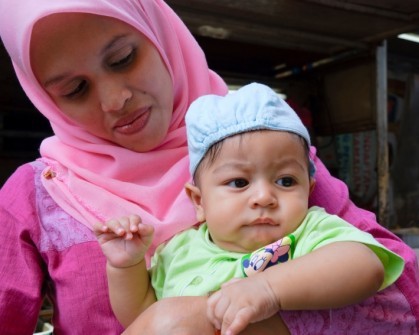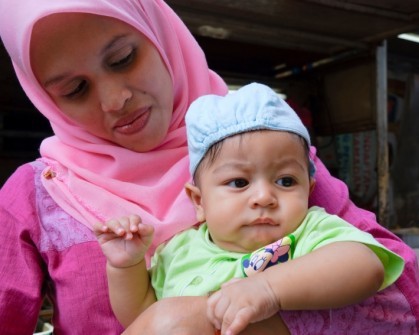 Ensure she has access to reproductive health care, then trust her to make her own decisions.Cross-posted from RH Reality Check.
Ensure she has access to reproductive health care, then trust her to make her own decisions.Cross-posted from RH Reality Check.
Who’s afraid of climate change? Well, I am, but not necessarily for the reasons you may think. I’m afraid that the recent, much-deserved attention to climate change will revive some of the old alarmist debates on population. And with those debates, I’m worried that the specter of population control will rear its ugly head again.
You see, as a woman of color, I am particularly sensitive to population-control arguments. After all, claims of “overpopulation” usually target women who look like me.
Throughout the 20th century, coercive welfare policies led to thousands of African-American women in the United States being sterilized without their consent in a procedure that came to be known as the “Mississippi Appendectomy.” In the 1950s, Puerto Rican women’s bodies were used as the testing grounds for controversial and experimental contraceptive trials, in part due to government perceptions that these experiments could help solve the island’s “population problem.” Around the same time, population control became enshrined within development programs in India and Bangladesh, where use of contraceptives and permanent sterilization were attached to food aid programs and the allocation of land and medical care. And, as recently as the late 1990s, hundreds of thousands of poor and indigenous women in Peru were sterilized against their will by their government under the banner of fighting poverty and overpopulation.
What does all of this have to do with the environment? Well, a lot. In the United States, fears of a “population crisis” exploded onto the scene back in the 1960s and 1970s with the rise of the environmental movement; environmentalists blamed population growth for everything from deforestation and desertification to global food shortages. Neo-Malthusian scholars and activists called for reducing food aid to starving populations in developing countries, and one well-known biologist famously suggested that sterilizing agents be placed into the American water supply.
Population alarmism gained quite a bit of support at the time, both among the general American public and among some members of the international development sector, who felt that controlling and reducing population growth would be beneficial to the global environment and the security of U.S. borders.
Luckily, population controllers were stopped in their tracks by a coalition of women’s health and rights reformers in the mid-1990s. At the 1994 International Conference on Population and Development (ICPD) meetings in Cairo, world leaders agreed that universal access to reproductive health services, within a broader focus on women’s rights and empowerment, would replace population control as the leading paradigm for the international family-planning movement. Focused on meeting women’s reproductive health needs, as opposed to controlling and reducing their fertility, this new paradigm was enshrined in a document known as the Cairo Consensus, which was ratified by 179 countries.
At around the same time, the population bubble burst. According to the Population Reference Bureau [PDF], nowadays the average woman in a developing country gives birth to 2.5 children, compared to 6 children in the early 1950s. In the industrialized world, this figure is even lower, with women having an average of 1.64 kids. Although in some regions like sub-Saharan Africa, rapid population growth continues to be carried along by demographic momentum, the trend toward the average woman giving birth to fewer children is a long-term, global phenomenon.
But is this enough to keep population controllers at bay? I’m not sure. Climate change has received much well-deserved attention lately in the news. And along with it comes the old, familiar population debate.
In 2009, the vice minister of China’s National Population and Family Planning Commission told an international audience that the Chinese one-child policy had proved to be an environmental success, adding that the 400 million births that have been prevented since the introduction of the policy have resulted in 1.8 billion fewer tons of carbon dioxide being emitted into the atmosphere each year. At the same time, some professors in the United States and Australia have proposed extra taxes for every child born beyond the replacement fertility level of two children per couple.
In addition, the British nonprofit Optimum Population Trust published a report arguing that each $7 spent on international family-planning projects could reduce carbon emissions by one ton, concluding that family planning as a method of reducing future emissions of carbon dioxide is significantly cheaper than many low-carbon technologies. [Editor’s note: OPT admitted to a flaw in that report and now says the $7 figure should not be quoted.] The organization created a website that offers consumers the opportunity to offset their carbon footprint by investing in family planning in developing countries. The site argues that investing in family planning is a “cost-effective and permanent way of reducing CO2 emissions and climate change” with “no downsides,” and offers wealthy Westerners the opportunity to consume their way into reducing their carbon footprints through reducing the childbearing of other women, rather than changing their own greenhouse-gas-emitting behaviors.
Not only do these approaches get into an ethical gray zone, they are based on faulty logic. We have to remember that the United States is the leading global emitter of greenhouse gases, producing 25 percent of the world’s emissions every year, even though our population accounts for just 4.5 percent of the world total. Many global South countries with rapidly growing populations, like Kenya, emit far fewer greenhouse gases than we do; the average Kenyan produces 0.3 tons of emissions every year, compared with the average American’s 20 tons of emissions. Clearly, it is what we do, rather than how many of us there are, that drives the climate bus.
As Lisa Hymas argued in her recent article, not all Americans consume the same volume of resources in the same way. Middle and upper-class Americans who drive multiple vehicles, build vacation homes, and race to buy every new technological gizmo that comes on the market have a significantly higher carbon footprint than the working class and the poor. At the same time, we have to think about the bigger actors that dwarf all of us in their climate-changing behaviors. Mega oil corporations, for example, earn billions of dollars in profits when they extract, refine, and sell fossil-fuel products. And, how could we ever forget the role of the U.S. military in this conversation? Its atmosphere-polluting activities are often hidden in the debates over climate change and population growth — a shocking fact, considering that the U.S. military is the single largest consumer of oil in the world.

Read more on population. Check out our series 7 Billion: What to expect when you're expanding
Climate change does, however, offer us opportunities to address women’s human and reproductive rights, but the connections must be made in the right way. Ensuring universal access to comprehensive reproductive-health services (including emergency obstetric care, both hormonal and barrier methods of contraception, diagnosis and treatment of sexually transmitted infections, HIV testing, counseling and treatment, and referrals for services for gender-based violence) promotes basic human rights — all women have the right to control their reproductive and sexual lives — and are important components of a gender-sensitive approach to adapting to the effects of climate change. Supporting coercive population interventions among the poor as a means of mitigating or preventing climate change, on the other hand, is not a defensible approach.
We must be ever vigilant, keeping the principles of reproductive health, reproductive rights, and reproductive justice for women at the heart of the approach. Through this framework, and the protection of women’s rights to have children, to not have children, and to parent the children they do have, we can remain on the right side of both the climate-justice and reproductive-justice debates.




